#suffrage
Text

Republicans are a numerical minority and can only win by restricting who votes. Don’t let them disenfranchise you.
#voting by mail#republican assholes#traitor trump#crooked donald#resist#never Trump#suffrage#disenfranchise
593 notes
·
View notes
Text
If Republicans want to start forcing 16 and 17 year olds to work 40 hour weeks, then the fucking voting age should be 16.
Fucking. pricks.
830 notes
·
View notes
Text

Popular Mechanics, June 1911
2K notes
·
View notes
Text
Incomplete vs. overshoot
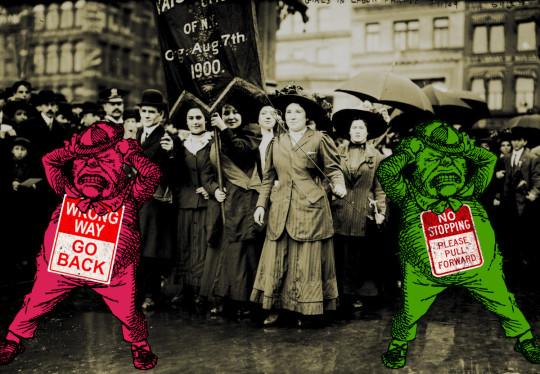
I'm on tour with my new novel The Bezzle! Catch me TONIGHT in Seattle (Feb 26) with Neal Stephenson, then Portland, Phoenix and more!

You know the "horseshoe theory," right? "The far-left and the far-right, rather than being at opposite and opposing ends of a linear continuum of the political spectrum, closely resemble each other, analogous to the way that the opposite ends of a horseshoe are close together":
https://en.wikipedia.org/wiki/Horseshoe_theory
It's a theory that only makes sense if you don't know much about the right and the left and what each side wants out of politics.
Take women's suffrage. The early suffragists ("suffragettes" in the UK) were mostly interested in votes for affluent, white women – not women as a body. Today's left criticizes the suffrage movement on the basis that they didn't go far enough:
https://www.npr.org/2011/03/25/134849480/the-root-how-racism-tainted-womens-suffrage
Contrast that with Christian Dominionists – the cranks who think that embryos are people (though presumably not for the purpose of calculating a state's electoral college vote? Though it would be cool if presidential elections turned on which side of a state line a fertility clinic's chest-freezer rested on):
https://www.wnycstudios.org/podcasts/otm/segments/how-alabama-ivf-ruling-was-influenced-christian-nationalism-on-the-media?tab=summary
These people are part of a far-right coalition that wants to abolish votes for women. As billionaire far-right bagman Peter Thiel wrote that he thought it was a mistake to let women vote at all:
https://www.cato-unbound.org/2009/04/13/peter-thiel/education-libertarian/
Superficially, there's some horseshoe theory action going on here. The left thinks the suffragists were wrong. The right thinks they were wrong, too. Therefore, the left and the right agree!
Well, they agree that the suffragists were wrong, but for opposite reasons – and far, far more importantly, they totally disagree about what they want. The right wants a world where no women can vote. The left wants a world where all women can vote. The idea that the right and the left agree on women's suffrage is, as the physicists say, "not even wrong."
It's the kind of wrong that can only be captured by citing scripture, specifically, A Fish Called Wanda, 6E, 79: "The central message of Buddhism is not 'Every man for himself.' And the London Underground is not a political movement. Those are all mistakes, Otto. I looked them up."
Or take the New Deal. While the New Deal set its sites on liberating workers from precarity, abuse and corruption, the Dealers – like the suffragists – had huge gaps in their program, omitting people of color, indigenous people, women, queer people, etc. There are lots of leftists who criticize the New Deal on this basis: it didn't go far enough:
https://livingnewdeal.org/new-deal-and-race/
But for the past 40 years, America has seen a sustained, vicious assault on New Deal programs, from Social Security to Medicare to food stamps to labor rights to national parks, funded by billionaires who want to bring back the Gilded Age and turn us all into forelock-tugging plebs:
https://pluralistic.net/2022/11/06/the-end-of-the-road-to-serfdom/
If you only view politics as a game of elementary school cliques, you might say that the left and the right are meeting again. The left says Roosevelt got it wrong with the New Deal (because he left out so many people). The right says FDR was wrong for doing the New Deal in the first place. Therefore, the left and the right agree, right?
Obviously wrong. Obviously. Again, the important thing is why the left and the right think the New Deal deserves criticism. The important thing is what the left and the right want. The left wants universal liberation. The right wants us all in economic chains. They do not agree.
It's not always just politics, either. Take the old, good internet. That was an internet defined by technological self-determination, a wild and wooly internet where there were few gatekeepers, where disfavored groups could find each other and make common cause, where users who were threatened by the greed of the shareholders behind big services could install blockers, mods, alternative clients and other "adversarial interoperability" tools that seized the means of computation.
Today's enshitternet – "five giant websites, filled with screenshots of the other four" (h/t Tom Eastman) – is orders of magnitude more populous than that old, good internet. The enshitternet has billions of users, and they are legally – and technologically – prevented from taking any self-help measures when the owners of services change them to shift value from users to themselves:
https://pluralistic.net/2023/02/19/twiddler/
The anti-enshittification movement rightly criticizes the old, good internet because it wasn't inclusive enough. It was a system almost exclusively hospitable to affluent, privileged people – the people who least needed the liberatory power of technology.
Likewise pro-enshittification monopolists – billionaires and their useful idiots – deplore the old, good internet because it gave its users too much power. For them, ad-blocking, alternative clients, mods, reverse-engineering and so on were all bugs, not features. For them, the enshitternet is great because businesses can literally criminalize taking action to protect yourself from their predatory impulses:
https://pluralistic.net/2022/10/20/benevolent-dictators/#felony-contempt-of-business-model
Superficially, it seems like the pro- and anti-enshittification forces agree – they both agree that the old, good internet was a mistake. But the difference that matters here is that the pro-enshittification side wants everyone mired in the enshitternet forever, living with what Jay Freeman calls "Felony contempt of business-model." By contrast, the disenshittification side wants a new, good internet that gives every user – not just a handful of techies – the power to decide how the digital systems they work use, and to be able to alter or reconfigure them to suit their own needs.
The horsehoe theory only makes sense if you don't take into account the beliefs and goals of each side. Politics aren't just a matter of who you agree with on a given issue – the real issue is what you're trying to accomplish.

If you'd like an essay-formatted version of this post to read or share, here's a link to it on pluralistic.net, my surveillance-free, ad-free, tracker-free blog:
https://pluralistic.net/2024/02/26/horsehoe-crab/#substantive-disagreement
#pluralistic#politics#suffrage#womens rights#new deal#civil rights#race#enshitternet#new good internet#old good internet
122 notes
·
View notes
Photo

Black and white photograph postcard of a cat wearing a straw hat holding up a sign with the slogan "Votes for Women."
Ann Lewis Women's Suffrage Collection
2K notes
·
View notes
Text
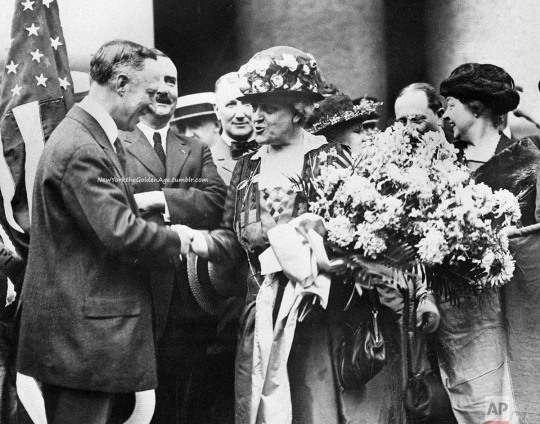
Former NY Governor Alfred E. Smith welcomes Carrie Chapman Catt, women's suffrage leader, on her triumphal return from Tennessee, August 27, 1920. Tennessee was the last state to ratify the 19th Amendment, giving women the right to vote. Miss Catt carries a bouquet of blue and yellow flowers, colors of the National American Woman's Suffrage Association.
Photo: Associated Press
#vintage New York#1920s#Carrie Chapman Catt#women's suffrage#19th Amendment#suffrage#suffragist#August 27#27 August#Al Smith#27 Aug.#Aug. 27#triumph#Constitutional amendment#right to vote
119 notes
·
View notes
Text
~ Helen Keller ~
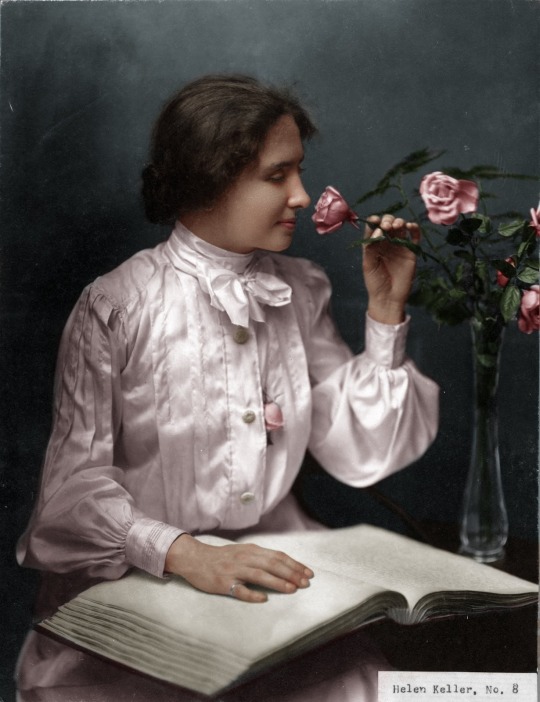
Helen Keller (colorized)
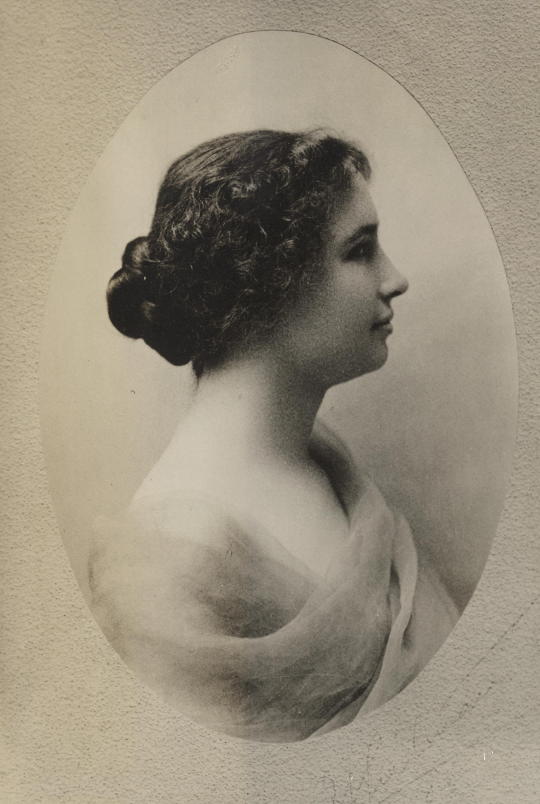
Miss Helen Keller - Portrait US Library of Congress
Helen Keller was an author, lecturer, suffragists and crusader for the handicapped. Born in Tuscumbia, Alabama, She lost her sight and hearing at the age of nineteen months to an illness now believed to have been scarlet fever. Five years later, on the advice of Alexander Graham Bell, her parents applied to the Perkins Institute for the Blind in Boston for a teacher, and from that school hired Anne Mansfield Sullivan.
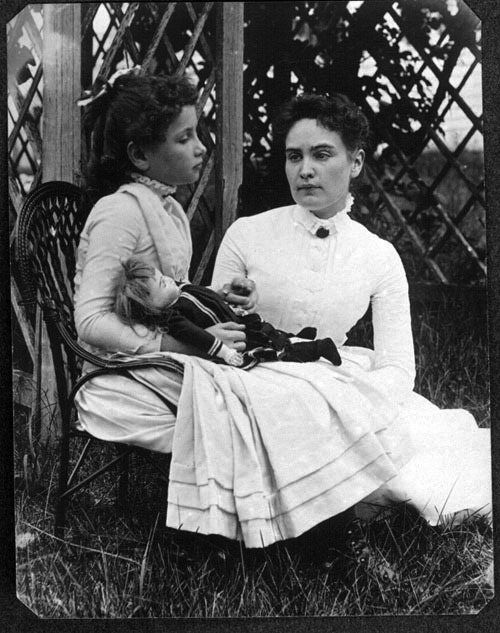
Keller (left) with Anne Sullivan vacationing on Cape Cod in July 1888
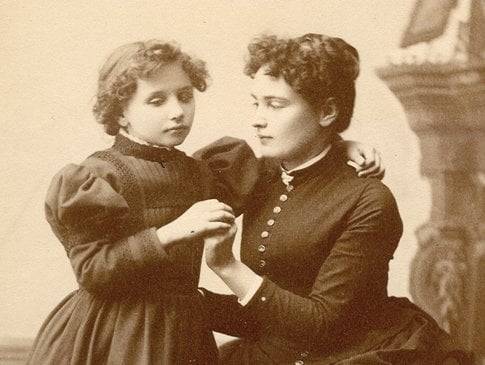
Through Sullivan’s extraordinary instruction, the little girl learned to understand and communicate with the world around her. She went on to acquire an excellent education and to become an important influence on the treatment of the blind and deaf.
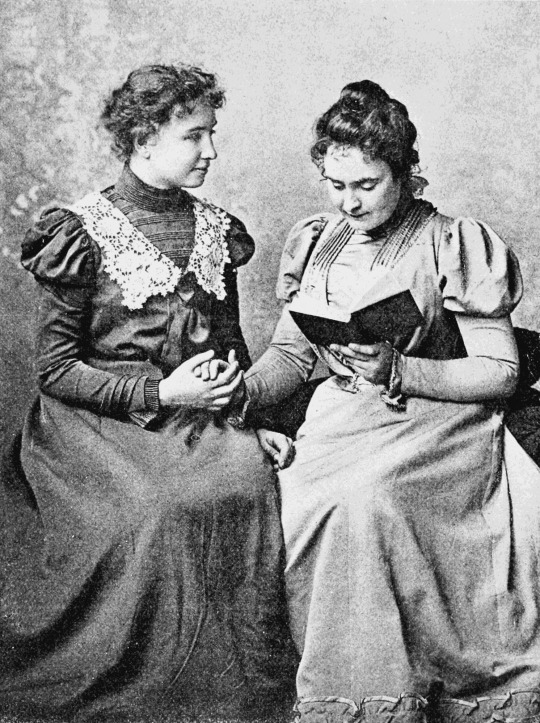
Helen Keller in 1899 with lifelong companion and teacher Anne Sullivan. Photo taken by Alexander Graham Bell at his School of Vocal Physiology and Mechanics of Speech.
Her unprecedented accomplishments in overcoming her disabilities made her a celebrity at an early age; at twelve she published an autobiographical sketch in the Youth’s Companion, and during her junior year at Radcliffe, she produced her first book, The Story of My Life, still in print in over fifty languages.
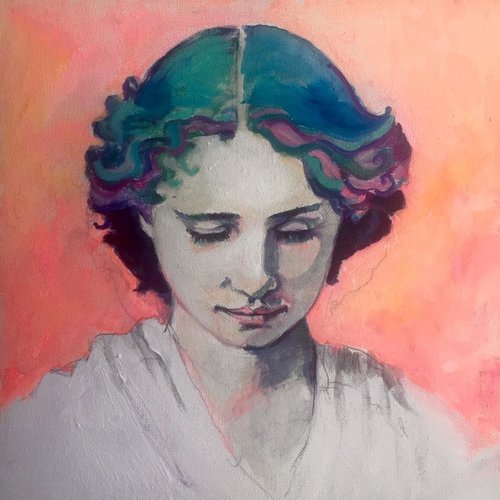
Helen Keller — Groundbreaking Girls
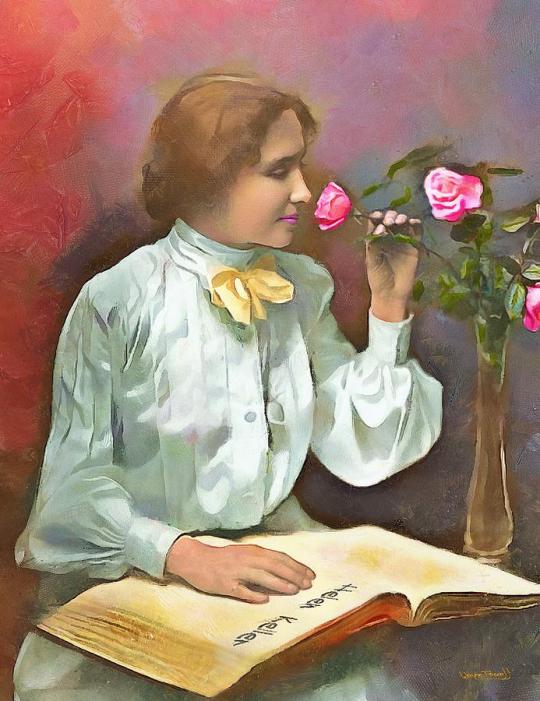
Painting of Keller's colorized portrait by Wayne Pascall
Her friendship with Mark Twain
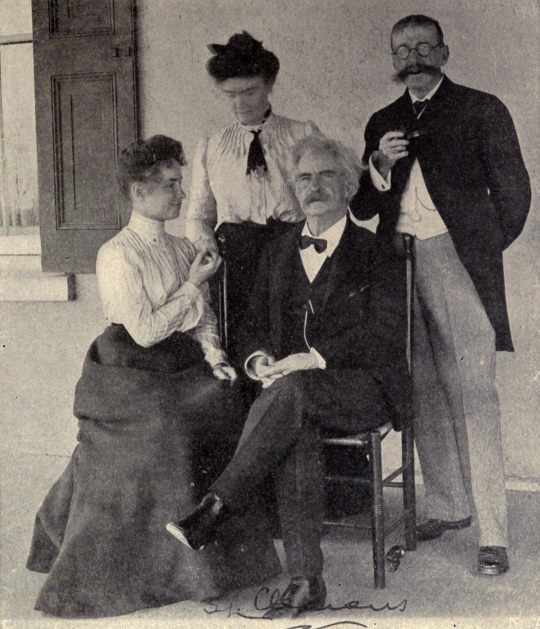
"Helen Keller, Miss Sullivan, Mark Twain and Laurence Hutton."
“From that day until his death we were friends,” Keller recalled later. She was already a fan of his work and thrilled to his deep voice and his many hand gestures, which she followed with her own fingertips. She wrote of him:
"He entered into my limited world with enthusiasm just as he might have explored Mars. Blindness was an adventure that kindled his curiosity. He treated me not as a freak, but as a handicapped woman seeking a way to circumvent extraordinary difficulties. There was something of divine apprehension in this rare naturalness towards those who differ from others in external circumstances."

Helen Keller with Mark Twain - Twain came to Keller’s defense, after reading in her book about a plagiarism scandal that occurred in 1892 when, at only twelve years old, she was accused of lifting her short story “The Frost King” from Margaret Canby’s “Frost Fairies.” Though a tribunal acquitted Keller of the charges, the incident still pissed off Twain. The letter is attached to the photo above
Letters between Mark Twain and Helen Keller.
Though Helen hailed from a respectable Southern family, 19th-century America was flummoxed by the prospect of teaching a deaf-blind girl to talk, read, and learn. Helen’s tutor and governess, Annie Sullivan, fought for her admission to various schools that offered special education. But the cost of educating someone like Helen was high. Clemens wrote to a rich friend on her behalf:
"It won’t do for America to allow this marvelous child to retire from her studies because of poverty. If she can go on with them she will make a fame that will endure in history for centuries. Along her special illness she is the most extraordinary product of all the ages…lay siege to your husband & get him to interest himself and Messrs. John D. & William Rockefeller & the other Standard Oil chiefs in Helen’s case; get them to subscribe an annual aggregate of six or seven hundred or a thousand dollars- & agree to continue this for three or four years, until she has completed her college course…."
Thanks to his intervention, the support of his friend Henry Rogers and Standard Oil, Helen was able to complete her education and graduate cum laude from Harvard’s Radcliffe College. Clemens and Keller remained friends for the rest of his life. They shared an interest in radical politics and a love for life despite their different temperaments. Helen, an avowed optimist, often made fun of Clemens for his avowed pessimism, telling him she didn’t believe a word of his sardonic jokes. As for Clemens, Chambliss writes that he felt she was one of the most important historical figures of all time, “the most wondrous person of her sex that has existed on this earth since Joan of Arc.”
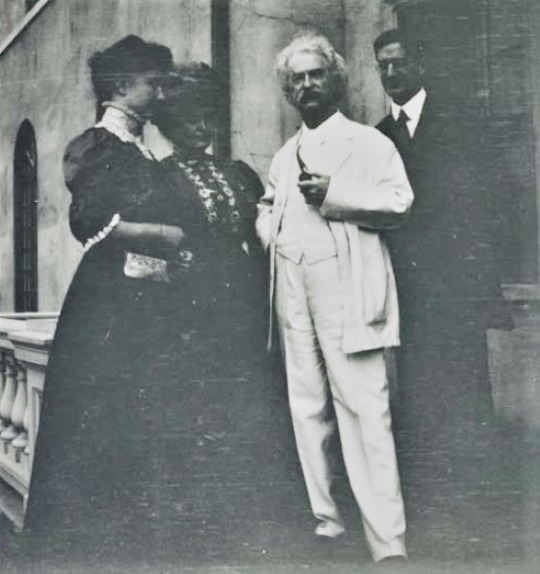
Keller, Sullivan, Twain, & Sullivan’s husband John Macy above at Twain’s home
We also have Twain—not playwright William Gibson—to thank for the “miracle worker” title given to Keller’s teacher, Anne Sullivan. As a tribute to Sullivan for her tireless work with Keller, he presented her with a postcard that read, “To Mrs. John Sullivan Macy with warm regard & with limitless admiration of the wonders she has performed as a ‘miracle-worker.’” In his 1903 letter to Keller, he called Sullivan “your other half… for it took the pair of you to make complete and perfect whole.”
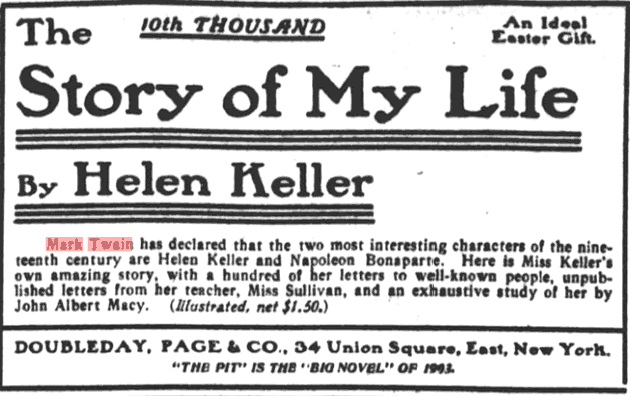
Twain was especially impressed by Keller’s autobiography, writing to her, “I am charmed with your book—enchanted.” (See his endorsement in a 1903 advertisement, above.)
Keller & Clemens also shared a love of dogs
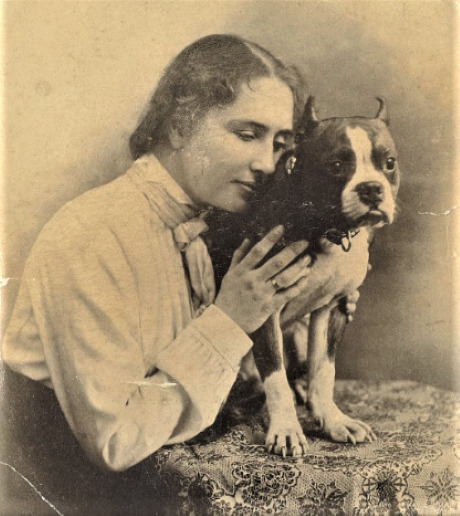
Helen Keller with her dog Sir Thomas.
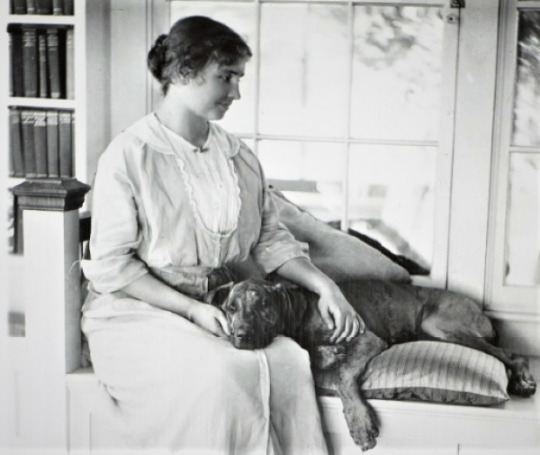
Helen Keller seated on a window bench with an arm around her dog Sieglinde.
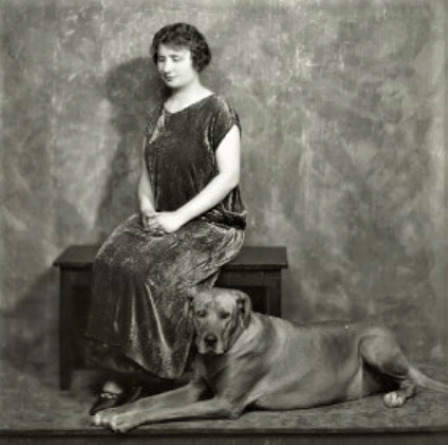
Helen Keller seated on a bench indoors, possibly in the photographer's studio wth a dog seated on the ground beside her.
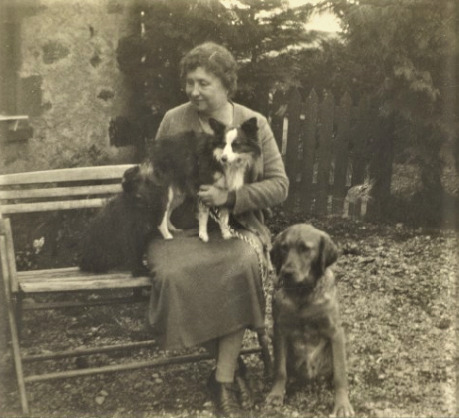
Helen Keller seated on a slatted bench in front of a Farm House in 1935 with her dogs Dileas, on her lap, Maida beside her & Golden.

Helen Keller teaching a girl sign language.
Widely honored throughout the world and invited to the White House by every U.S. president from Grover Cleveland to Lyndon B. Johnson, Keller altered the world’s perception of the capacities of the handicapped. More than any act in her long life, her courage, intelligence, and dedication combined to make her a symbol of the triumph of the human spirit over adversity.

Helen Keller - 1880-1968
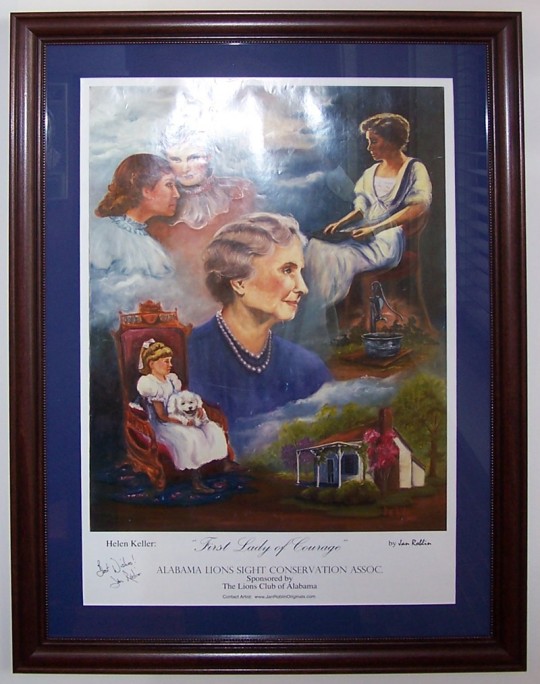
Helen Keller Archive
#helen keller#samuel clemens#mark twain#anne sullivan#anne sullivan macy#john macy#Henry Rogers#blind#sign language#braille#miracle worker#Alexander Graham Bell#Radcliffe College#suffragette#women's suffrage#suffrage#deaf#handicapped#cliff clavin#art
108 notes
·
View notes
Text

Ralph Barton, Making the Polls Attractive to the Anti-Suffragists, Puck, 30 February 1915.
Puck was the first successful humor magazine in the United States of colorful cartoons, caricatures and political satire of the issues of the day. It was founded in 1876 as a German-language publication by Joseph Keppler, an Austrian immigrant cartoonist.[1] Puck's first English-language edition was published in 1877, covering issues like New York City's Tammany Hall, presidential politics, and social issues of the late 19th century to the early 20th century.
"Puckish" means "childishly mischievous". This led Shakespeare's Puck character (from A Midsummer Night's Dream) to be recast as a charming near-naked boy and used as the title of the magazine. Puck was the first magazine to carry illustrated advertising and the first to successfully adopt full-color lithography printing for a weekly publication.
Puck was published from 1876 until 1918. (x)
#ralph barton#illustration#magazine#1915#humor#humor magazine#1915 illustration#vintage#feminism#feminism history#Anti-Suffragists#Anti-suffragism#suffrage movement#suffrage#voting rights#womens voting rights#political issue#political issues#votes for women#feminst humor#puck magazine#art#satire#political satire
44 notes
·
View notes
Text
I've occasionally posted old women's suffrage (and anti-suffragette) postcards, of which there were quite a few. There's a new (to me) online collection available that has some fascinating things.
19 notes
·
View notes
Text

“I have earned my own living since I was eighteen, can read and write good English and take an interest in the affairs of my country . . . many men who do none of these things, may vote indiscriminately.” Letter in support of suffrage for women, 5/23/1918.
Record Group 46: Records of the U.S. Senate
Series: Petitions and Related Documents That Were Presented, Read, or Tabled
File Unit: Petitions and Memorials, Resolutions of State Legislatures, and Related Documents which were Presented, Read, or Tabled during the 65th Congress
Transcription:
Olivia State Bank
Capital $25,000.00
Surplus $15,000.00
M.J. Dowling, President
J.M. Freeman, Vice President
Hattie S. Bordewich, Cashier
Harald Bordewich, Asst. Cashier
H. Griffith, Asst. Cashier
Olivia, Minnesota
May 23rd, 1918.
Hon. Frank B. Kellogg,
United States Senator,
Washington, D. C.
Dear Sir:
I have earned my own living since I was eighteen, can read and write good English and take an interest in the affairs of my country; I pay taxes and can only vote at school meetings and for County Superintendent of Schools, while many men who do none of these things, may vote indiscriminately. I want equal suffrage for women and would appreciate the aid of our Minnesota delegation in Congress to this end.
Yours respectfully,
[signed] Hattie S. Bordewich
#archivesgov#May 23#1918#1910s#suffrage#women's suffrage#votes for women#the right to petition the government for a redress of grievances#women's history
69 notes
·
View notes
Text



Georgina Agnes Brackenbury, Emmeline Pankhurst, 1927
Olive Edis, Emmeline Pankhurst, 1920s
Olive Edis, Emmeline Pankhurst, ca. 1920s
Emmeline Pankhurst (née Goulden; 15 July 1858 – 14 June 1928) British political activist who, with her daughters, organised the United Kingdom’s suffrage movement and helped UK women claim their right to vote.
#Georgina Agnes Brackenbury#Olive Edis#portrait#portrait painting#portrait photography#portraiture#emmeline pankhurst#feminism#feminist#women's suffrage#suffrage#the vote#activism#womens rights#feminist activism#feminist action#british history#british women#art history#aesthetictumblr#tumblraesthetic#tumblrpic#tumblrpictures#tumblr art#tumblrstyle#artists on tumblr#aesthetic
25 notes
·
View notes
Text
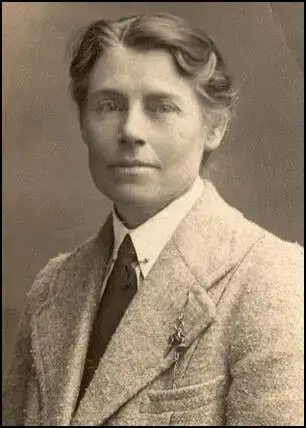



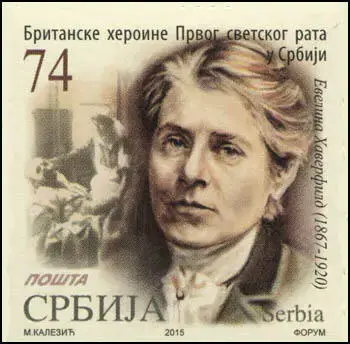
The leading Scottish suffragette, Evelina Haverfield, was born at Inverlochy Castle on August 9th 1867.
Evelina’s birth is recorded as ‘Honourable Evilena Scarlett’, she took the name Haverfield from her husband. Her childhood was divided between London and the Inverlochy estate. In 1880 she went to school in Dusseldorf, Germany, after which she married Major Henry Haverfield at the age of 19., who was 20 years her senior. The marriage is said to have been a happy one they had two sons together, The Major however died in 1896. Evelina married again two years later, a another military man, Major John Blaguy. This was not a happy union and after some time they drifted apart. The rest of her life was informed by devotion to a cause.
She became an enthusiastic supporter of the suffragette movement and was arrested during suffragette demonstrations in London for hitting an escorting police officer. Her only regret was not hitting him hard enough, promising to bring a revolver next time. During that heady time she met Vera Holme. Their companionship was to last the rest of her days.
At the outbreak of the First World War the suffragettes supported the war effort by founding a Women’s Voluntary Emergency Corps and a Women’s Voluntary Reserve Ambulance Corps. Evelina became commandant in chief of the latter, looking, it was said, every inch a soldier in her khaki uniform, although she later left after a disagreement of an undisclosed nature.
Evelina joined the Scottish Women’s Hospitals and devoted the next two years to overseas service with them. She served in Serbia with Elsie Inglis, as a hospital administrator and was part of a small group taken prisoner when the armies of the Central Powers overran Serbia in October and November 1915.
Under appalling conditions of poverty and military oppression, Evelina and those with her, struggled heroically through the winter to provide food and basic care for their wounded Serbian patients and some of the local civilian population. In the spring of 1916, Evelina and the other 'Scottish Women’ were released through the International Red Cross and returned to England.
In August 1916 Evelina went to Romania in charge of 18 ambulance and transport vehicles as part of two units of the Scottish Women’s Hospitals. These units were in support of Serbian soldiers fighting on the eastern Allied front. The stronger enemy invading armies drove the Russian, Romanian, and Serbian defenders out of southern Romania and north of the Danube river delta.
During this two-month retreat by the Allied forces, Evelina and the transport drivers were working non-stop under constant enemy fire, in desperate situations, while rescuing wounded soldiers and driving them to safety.
By early 1917, with the fighting on the eastern front over, and unable to return to Serbia because of the enemy occupation there, Evelina returned to England, where she remained until after the Armistice of November 1918. In England she raised money for clothing and canteens for Serbian soldiers, gave public speeches on behalf of Serbian relief, and helped to found a Serbian Red Cross Society in Britain.
After the Armistice she returned to Serbia to supervise the distribution of much needed food, clothing, and medical supplies. When this was done, in 1919, she made plans to found a home for Serbian war orphans in a Serbian mountain village. It was there, in Baijna Bashta, that she contracted pneumonia, probably brought on by overwork and fatigue, and died prematurely at the age of 52, revered and honoured by the Serbs for her five years of humanitarian work on their behalf. The Serbs issued a stamp commemorating this remarkable women in 2015, a woman few Scots have even heard of…….
Buried in Serbia today, Evelina’s gravestone reads:
‘Hear lies the body of the honourable Evelina Haverfield youngest daughter of William Scarlett 3rd Baron Abinger and of Helen ne Magruder his wife of Inverloky Castle Fort William Scotland who finished her work in Bajina Bashta March 21st 1920 through the war 1914-1920 She worked for the Serbian people with untiring zeal. A straight fighter as traight rider and a most loyal friend. R.I.P’
In 2015 Evalina was one of five Scottish women and one English women, who worked as doctors, nurses and drivers feature on a series of stamps in Serbia, the others were Dr Elsie Inglis a campaigner for women's suffrage and the founder of the Scottish Women Hospitals in Serbia. Dr Inglis was one of the first female graduates at the University of Edinburgh.
Dr Elizabeth Ross, one of the first women to obtain a medical degree at the University of Glasgow. She travelled to Serbia as a volunteer and tragically passed away during the typhoid epidemic in 1915.
Dr Katherine MacPhail OBE, involved in humanitarian work in Serbia throughout WW1. She is remembered for opening the first paediatric ward in Belgrade in 1921.
Dr Isabel Emslie Galloway Hutton who joined the Scottish Women Hospitals as a volunteer in 1915 after she was turned away by the War Office in London. She served in France, Greece and Serbia until 1920.
The sixth was English woman, Captain Flora Sandes, who was the only known British female to bear arms during WW1
33 notes
·
View notes
Text

🫧
20 notes
·
View notes
Text

Popular Mechanics, July 1913
2K notes
·
View notes
Text
Separated at Birth?
Our custom widget that checks for duplicated images suggested this unlikely pairing. See the original post for photo source details.
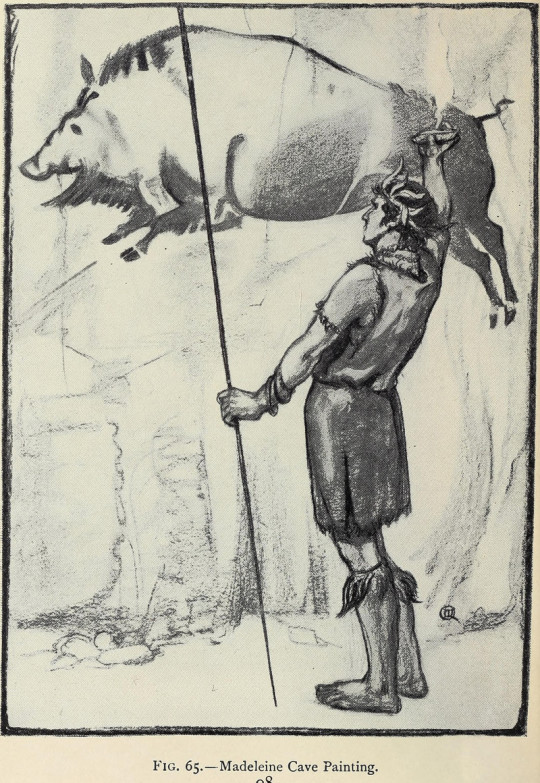
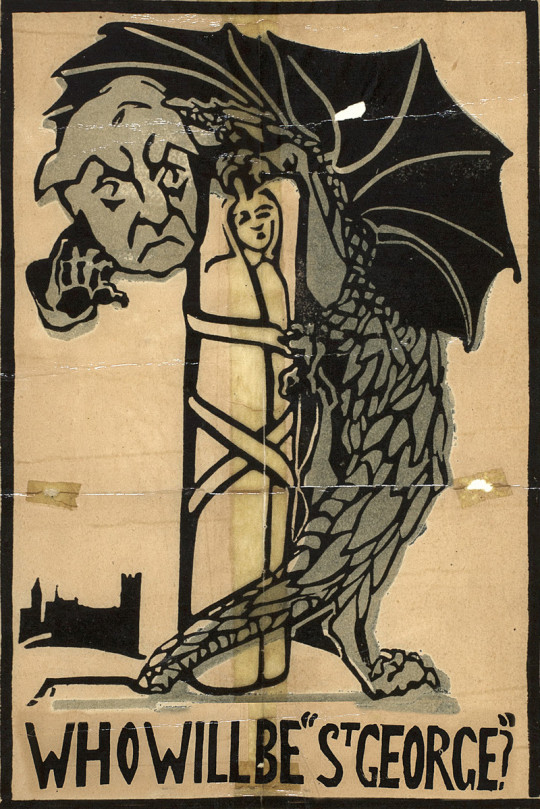
Wondering about this post? Wait for the dissertation (TBA). For now: Weblog ◆ Books ◆ Videos ◆ Music ◆ Etsy
#prehistoric#boar#caveman#vintage illustration#illustration#dragon#st. george#vintage poster#suffrage#poster
18 notes
·
View notes
Photo

Suffragists Protest Woodrow Wilson's Opposition to Woman Suffrage, October 1916.
#suffrage#women's suffrage#women's rights#woodrow wilson#protest#american history#women's history#sepia
138 notes
·
View notes